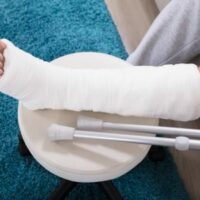In An Accident, Bones Can Break In Different Ways

We tend to think of broken bones as being broken or not broken. To some extent that is true, but many people—and jurors who will evaluate your personal injury case—don’t think much about the different kinds of broken bones. Like many kinds of injuries, the type of broken bones you have can affect how quickly you will recover and whether you have long-term disability.
Getting Medical Attention
Broken bones require immediate medical attention, but that usually isn’t an issue, because broken bones often are so painful that the victim seeks out medical attention.
Unlike strains or sprains to ligaments, broken bones will usually show up on the standard X-rays that are given in hospital emergency rooms. Broken bones also don’t manifest later on—they’re either there when you get your X-ray or they aren’t (unless there’s some problem with the X-ray itself, or in the reading of your X-ray).
Types of Breaks
There are many kinds of broken bones, with varying severity. They include:
- Partial fractures – This is the more common type of break, and the kind that most people think of. A partial fracture is like a crack, but the crack doesn’t split the bone, or go all the way through the bone. It is like a hairline fracture or a slight break from a minor bending of the bone.
- Complete fracture – this is like a partial fracture, except with a complete fracture, the fracture goes all the way through the bone—although the bone is still in place, and intact.
- Nondisplaced Fracture – Like a complete fracture, a nondisplaced fracture goes all the way through the bone, and is more than superficial—it actually is cutting the bone into two pieces. However, the pieces are still aligned, and in place. The good news is that as long as the bone is stabilized when healing, it will seal up without invasive medical intervention.
- Displaced Fractures – This is much more serious. With a displaced fracture, not only is the bone split in two, but one part of the bone has moved, thus meaning that the two parts of the bone no longer “line up.” Medical intervention such as rods, pins, or surgery may be needed to get the two parts of the bone to line up so that the bone heals properly.
- A relative of the displaced fracture is the open, or compound fracture. Here, one part of the bone is jutting out of or protruding through the skin. This is a multi-part injury, as you not only have a very serious injury to the bone, but the part of the bone that is sticking out has also pierced and injured the tissue, muscle, and nerves that surround it.
- Comminuted fractures – this is like a crushing injury. Imagine a piece of wood, and you smash it with a rock. There is no one clean break; rather, there are lots of little pieces of wood (or your bone) everywhere. Surgery is often needed, and like a compound fracture, there may be other injuries to the structures around the bone from the crushing force.
Call the Knoxville personal injury attorneys at Fox, Farley, Willis & Burnette, for help if you sustain any kind of injury in any kind of accident.
Resource:
orthopedic-institute.org/fracture-care/types-of-fractures/











